Summer Study: What Do Phase I Scholars Do?
DO‑IT Phase I Scholars participate in a two-week, live-in Summer Study session on the UW Seattle campus. They learn about college life; explore the Internet; interact with peers, staff, and mentors; and have fun. The DO‑IT Scholars program started in 1993 as an experimental project for teens with disabilities nationwide. It is currently open to Washington State teens and is supported by the State of Washington, the Boeing Company, the Microsoft Corporation, and the National Oceanic and Atmospheric Administration.
The Life of Living in a Dorm
Have you ever wondered what life is like living in a dorm? There are many pros and cons to this style of living on college campus.
Pro: Hang out with your friends all the time without parents telling you what to do!
Con: You may miss your family, miss your room and bed at home, and feel like your space is crowded when sharing a small room with a roommate.
Pro: With certain types of meal plans, you can qualify for an all you can eat buffet!
Con: You have to figure out what you want to eat or can feel sick if you eat too much junk food.
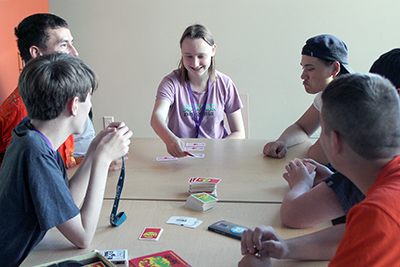
Pro: Stay up all night with your friends. You’re never bored because you’re so busy!
Con: Sitting through long lectures and a day full of activities without enough sleep can make you very tired.
Pro: You have more independence and can ask for help as needed, with staff always available or on call!
Con: Accommodations need to be requested in advance and may take time to be granted. You should plan in advance before moving into your dorm for what you need. While all people should have access and be treated fair and equal, people with disabilities often need to advocate for themselves when they need something.
Intersectionality and Discrimination
If you look up people with disabilities, chances are you’ll find a picture of a straight white person who completely fits gender norms. Modern society often pushes the belief that one person can only belong to one minority group. Unlike these pictures would have you believe, the disabled community is extremely diverse.
Like any minority, we aren’t made up of one specific type of people, and our issues can go far beyond a lack of access and/or ableism. Because our community is so diverse, lots of us have to deal with intersecting oppressions.
Many people in the disabled community are also LGBT+ (lesbian, gay, bisexual, transgender, plus) and/or people of color. Often, they can find their voices minimized and unheard, or that people only focus on their disability, rather than other aspects of their identity. For LGBT+ people, this can reinforce the narrow view of what constitutes as “normal” gender identity, and often leaves them outside of the conversations about them and without representation either an LGBT+ person or a person with a disability.
For disabled people of color, especially those who are LGBT+, they find they often face discrimination for all sides of their identity and become marginalized because they aren’t prototypical for any specific identity. For example, even though three black LGBT+ women started the Black Lives Matter movement, most media coverage focuses on black men (The Conversation, 2016).
Societal expectations and stereotypes can also influence encounters with our judicial system, represented through police encounters and the prison system. For example, as seen in the statistics, police encounters are more likely to be deadly for both people of color and people with disabilities compared to people with majority identities (Mapping police violence, 2018; Hause & Melber, 2016).
For someone with both of these identities, it raises the likelihood even higher. Many mental disabilities can cause a person to think differently, misunderstand, communicate ineffectively, or not be able to control their thoughts or statements. Paired with assumptions and stereotypes based on race, disabled people of color have higher rates of being shot, imprisoned, and injured by police due to a lack of understanding (Davis, 2009; Mapping police violence, 2018; Oberholtzer, 2017; O’Hara, 2016).
Furthermore, people with disabilities, as well as those of other identities, can often be sentenced to jail or prison at higher rates, due to a lack of ability to understand the legal process, money to hire a better lawyer, and stereotypes within the system and then have higher likelihood of mistreatment in prison (Davis, 2009; Oberholtzer, 2017). As Oberholtzer states, “Less than half of jails are equipped to offer mental health treatment. Just 21% have programs to support mentally ill people upon release.” Those who identify as LGBT+ also report higher rates of abuse (Amnesty International, 2001).
The way LGBT+ disabled people of color are treated is extremely telling of how the police and prison systems are set up to only understand the “norm,” especially here in America. Racism, ableism, and sexism are prevalent in society, and our judicial system.
This is why we need to combat discrimination across all minorities, particularly where intersections lie. Society is often less safe and welcoming for a person with a disability, a person of color, and those who are LGBT+.
References:
Amnesty International. (2001). Crimes of hate, conspiracy of silence: torture and ill-treatment based on sexual identity. Oxford: The Alden Press.
Davis, L. A. (2009). People with intellectual disability in the criminal justice system: Victims and suspects. The Arc. Retrieved from https://www.dcjs.virginia.gov/sites/dcjs.virginia.gov/files/part_12_vict...
Hause, M. & Melber, A. (2016). Half of people killed by police have a disability: Report. NBC News. Retrieved from https://nbcnews.to/2yEtVVO
Mapping police violence. (2018). Retrieved from https://mappingpoliceviolence.org/
O’Hara, M. (2016). Up to half of people killed by US police are disabled. The Guardian. Retrieved from http://bit.ly/2yifFT9
Oberholtzer, E. (2017). Police, courts, jails, and prisons all fail disabled people. Prison Policy Initiative. Retrieved from https://www.prisonpolicy.org/blog/2017/08/23/disability/
The Conversation (2016). Intersectionality: How gender interacts with other social identities to shape bias. Retrieved from http://bit.ly/2RPo2Op
Disability and Employment
At a 3.9% rate of unemployment, the United States is on track for the lowest unemployment rates since World War I. You may see this as good news, but this statistic overlooks one of the largest minorities in the United States— the disabled. Of disabled workers that are of working age, over 35% are unemployed. This statistic is in stark contrast workers without disabilities (3.9%). You may ask what has caused this huge divide in employment rates, and the answer isn’t as simple as you might think.
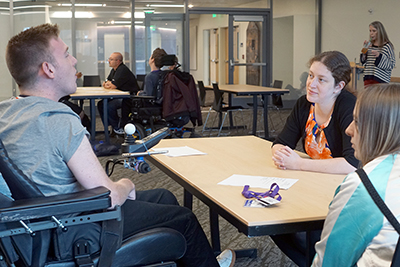
A common factor that causes this divide is disability stigma and ableism. People with disabilities are often thought to need extra help or be less of a hard worker than an able-bodied employee. This has been proven false in many studies; they are often harder workers and need the same level of help as people without disabilities. Even so, some small businesses see a potential barrier in hiring disabled employees due to the costs associated with accommodations. The cost of accommodations is often 500 dollars.
Employment is one of the most important parts of adult life. The disabled community and allies fight against the stigma that is attached with “disability” to provide job opportunities for people with disabilities. By being more open about disability, we can work together to fight ableism.
How Ableism Affects People with Disabilities
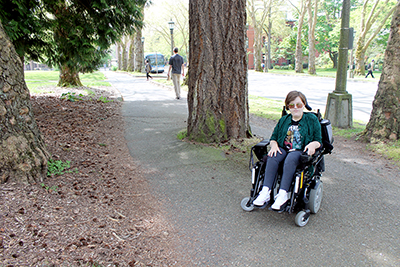
Ableism is a form of discrimination against people with disabilities, being seen as lesser or having their access controlled based on their abilities. In 2015, then presidential candidate Donald Trump mocked a reporter with a disability at a rally by pretending to suffer from muscle spasms. Ableism is still prominent in society. DO-IT Ambassadors and Scholars were eager to share their experiences in this regard.
“I have experienced ableism on the UW campus because of all the stairs,” said Lindsey, who uses a power chair. She also said the sidewalks are in bad shape, making traveling take longer and planning how to get around campus a challenge.
Lindsey and Vanessa, a fellow wheelchair user, also have had negative experiences with societal expectations. Waiters in restaurants have asked their parents or friends what they want. “I have experienced ableism because of the way people look at me. They look at me like a baby when I’m an adult,” said Vanessa.
Izzy has dyslexia, a learning disability that makes it hard to read, write, and spell. “In 3rd grade I asked this kid how to spell a word,” Izzy said, “and he wouldn’t spell it for me. He called me an idiot.” This can be a common misconception, as disabilities like attention deficit hyperactivity disorder, dyslexia, and dysgraphia can be confused with general ignorance.
Takashi, who has impaired vision, said his disability is usually invisible, but when it is noticed or mentioned, he is told he is an inspiration. Some people are inspired by seeing people with disabilities simply their normal life. Often the bar is set so low for people with disabilities, just getting up in the morning is celebrated as inspirational.
Cheyann, who is blind, uses a cane and often asks people for directions. “People see me as fragile,” she said. “I was walking in the pool and my hands were out to protect me. A man ran out, screaming at me, trying to grab my hands,” she described an experience that stood out to her. “It just annoyed me that people assume I’m doing something wrong.”
People with disabilities are often not taken seriously or treated as equals to “normal” people. While it is usually a subconscious bias, it is obvious there is a divide between disabled and non-disabled people. The media continues to propagate a narrative that people with disabilities are to be pitied or inspirational rather than just normal human beings.
The more we refuse to recognize the potential of disabled people, the more everyday people become ignorant of reality. Change starts with everyone working together. Ableism is defeated by actually talking to people with disabilities and realizing they are people first.
Summer Study as a Whole
Dillen: The DO-IT Summer Study program allows students with disabilities to interact within a community. As someone who is generally outgoing, my concerns were not so much about socializing, but rather about being in a dorm-style environment as I had not done that before. I was excited to meet those with similar disabilities—due to my cerebral palsy, I’ve experienced things such as spinal fusion surgery that cannot be fully understood by my classmates at school.
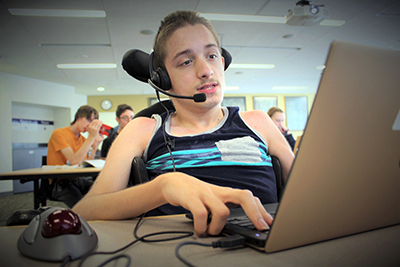
At Summer Study, my favorite day was spent at Microsoft, as it relates to computer science, which I want to major in. I found it interesting to hear about ways people can leverage their disability to improve other sectors they have a passion for. I also enjoyed classroom-based activities, which covered both disability-related and non-disability-related topics.
In the evenings at DO-IT, we engaged in fun activities, such as playing board games and socializing. One thing that makes DO‑IT unique is that many staff and interns have disabilities, which promotes an open environment for Scholars to express concerns about disability and non-disability topics. Overall Summer Study was a great experience.
Dean: When I first arrived at DO-IT Summer Study 2018, I was astronomically anxious. It was a new situation, full of people who I’d never met before. Before this, I’d never been this far away from home for more than a day or two. Because of my disability (autism spectrum disorder), I have a hard time adapting to new situations and meeting new people, so that made the icebreaker at the barbecue dinner on the first night a bit of a challenge. I was worried that my time here wouldn’t get any better; that I’d feel this uncomfortable and homesick the entire time. And, as ridiculous as it sounds, I was a little bit afraid that nobody would really like me here. Thankfully, all of these worries were eliminated over the next day or two, and I began to actually enjoy my time here.
We ended up taking part in some fantastic activities. We went on field trips, such as to the KUOW radio station, which, as an avid music enthusiast, I really enjoyed. I got to look at the equipment in the recording rooms and learned some tips on interviewing people. I loved this visit, especially because I got to experience it with my newfound friends.
We also learned important skills for college and beyond during Summer Study. For example, I knew almost nothing about the difference between getting accommodations in high school versus getting accommodations in college. We even got to practice informing real professors about our disabilities and accommodations in a real-life situation.
It was also an invaluable time to practice our independence and self-advocacy skills. At DO-IT, you’re expected to act on your own and ask for help if you need it. The environment here at DO-IT is very supportive, and there’s an entire network of friends behind you. Everyone is willing to help you; all you gotta do is ask!
Accessibility Within Public Transportation
The Merriam-Webster dictionary describes being disabled as being “impaired or limited by a physical, mental, cognitive, or developmental condition.” Most people with disabilities aren’t able to complete certain tasks as they are set up in modern society—for example, boarding a bus or riding a bicycle.
Riding a standard bus can be challenging if the bus has not provided accessible services. Many buses kneel to lower the door closer to a curb, or have retractable ramps or lifts that bring the wheelchair into the vehicle. After boarding the bus, there should be spots for wheelchairs to be secured inside.
Buses are not the only transportation option. Most commercial airline provide transfer aisle chairs, waive luggage fees, and allow service animals. Airline employees are also taught skills in talking and interacting with people with disabilities. Some airlines even have programs specialized for people on the autism spectrum or with anxiety-based disabilities.
For ground transportation, there are many accessible taxi options, including Uber’s Accessibility feature, Yellow Taxi’s ramped vans, and Dial-a-Ride Transportation (DART). Google Maps also offers accessibility options, which avoid obstacles and hills. Even something as simple as bicycling has become possible for most, with hand-powered bikes and other accessible options.
Modern technology has progressed to accommodate more people. While some areas may remain inaccessible, society is constantly improving to be more accepting and inclusive.
How People Become Friends at DO-IT
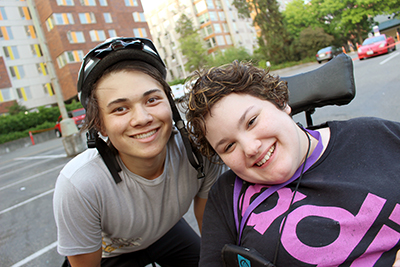
Maribel: The DO-IT Summer Study program is for people with disabilities like mine. For me, Summer Study isn’t just about making friends or doing projects; it is about taking in your accomplishments and knowing that you do not have to be afraid of going out into the world and achieving your dreams!
Sandra: When I first came to DO-IT, I didn’t know anyone, and I was scared that I wouldn’t fit in. I had also not been around a lot of people with disabilities before, so I didn’t know the right things to say or do. However, I quickly learned by talking to people that we all have different abilities. This helped me become friends with others.
When I first met Maribel, I didn’t know how to interact with her. But once I took the time to get to know her, I realized she is great! This made me realize you shouldn’t judge people by your first impression. Give yourself the opportunity to know the person. People with disabilities get judged all the time, which isn’t fair. There are great people in the world that you may not be giving yourself a chance to meet.